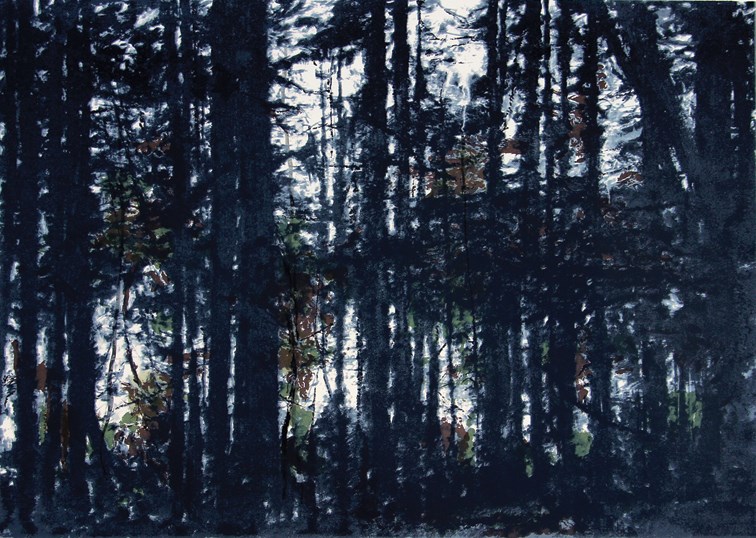Gordon Smith: Serigraphs, Seymour Art Gallery, until June 17. Talk by Marius Soska, Sunday, June 4 at 2 p.m., reception to follow (seymourartgallery.com).
Flecks of pink peek around white clouds and black tree trunks.
This particular splash of pink – closer to salmon belly than cartoon panther – rebels against the print’s bichromatic order. However, as Gordon Smith’s longtime collaborator Marius Soska explains, that wasn’t always the plan.
“This was a bit of an accident,” Soska says.
Between the absorbency of the Rives BFK paper and the ink mixture being not quite transparent enough, the print turned out darker than expected, capturing the “afternoon sun as it was setting,” Soska says.
It was a “lucky accident,” he says.
For 20 years Smith has entrusted Soska with the task of creating serigraphs of his paintings, many of which are currently hanging in the Seymour Art Gallery.
The partnership started when another screen printer ran into a problem with a Haida Gwaii artist’s image.
They needed the background colours to gradually darken “and they didn’t know how to do it,” Soska says.
They were desperate enough for a solution that they put an ad in the newspaper.
After growing up in what is now Slovakia and coming to Canada as a refugee, Soska had forged a career in screen printing. He’d wanted a career in fine arts, he recalls, smiling and adding: “Life turned out differently.”
“You can’t really make money (as an artist) and I had a family when I was reasonably young,” he says.
After responding to the ad, Soska showed the printer a different ink mix that gave the painting the subtlety of colour it had been lacking.
“The young fellow was so impressed he told Gordon about me.”
Smith eventually contacted him for what Soska calls “my audition.”
Asked why Smith picked him, Soska demurs.
“You would have to ask him what he thinks of me,” Soska says with a chuckle.
The conversations before making a print can be lengthy, with Smith going over fine details and invoking artists like Matisse. But afterward the talk becomes somewhat muted, Soska reports.
“He says, ‘It’s very good. Can you do something else for me?’”
Smith has said that about 50 times, allowing Soska to create a variety of serigraphs. The subject matter has ranged from largely untouched views of nature to subdued abstracts, but what has been a constant is the letter M, usually sketched just below the image.
It doesn’t stand for Marius, Soska assures me, but rather Marion, Smith’s late wife.
“Whenever I made the print, it had to go through her,” he says of Marion Smith. “She was a very good critic. She would tell (Smith), ‘This is crap.’”
As a younger man Soska might have bristled at criticism but he was at an age when he realized, as Winston Churchill put it, that while criticism may not be agreeable, it is necessary.
He also noted that Smith trusted Marion’s sharp eye, “And it worked for him.”
In 20 years there was just one print Soska was asked to redo. “Too much blue,” he recalls with a grin.
Over those years Soska found his discussions with Smith growing shorter.
“I could guess what his intentions are,” he says. “He gives me the opportunity to spread my wings every time I make a print.”
While his role is highlighted, the exhibition is a celebration of one of Canada’s finest painters, Soska says.
“I hope they realize the talent of Gordon Smith,” he says.
Soska is unfailingly modest about his role in adding colour and three-dimensionality to the work, describing himself as: “just a tool for Gordon’s art.”
Smith is the driver. He’s the car, he says, before adding what for Soska borders on braggadocio: “maybe a good car.”
Soska is uniformly good-natured (“Oh gosh, I’m old,” he chuckles) as he walks through two decades of work.
But when asked what the work means to him a steely certainty shows itself in Soska’s genial nature.
The volume of his speaking voice doesn’t change but his words are somehow heavier, as though he reached deep to get them.
“Very personal,” he says. “Every one of them I want to make it as good as possible. It’s not a job, it’s a calling. It’s a passion.”
And then Soska smiles and the air resumes its regular course through the gallery.
“I just hope that people like it,” he says. “I do the best that I can.”



